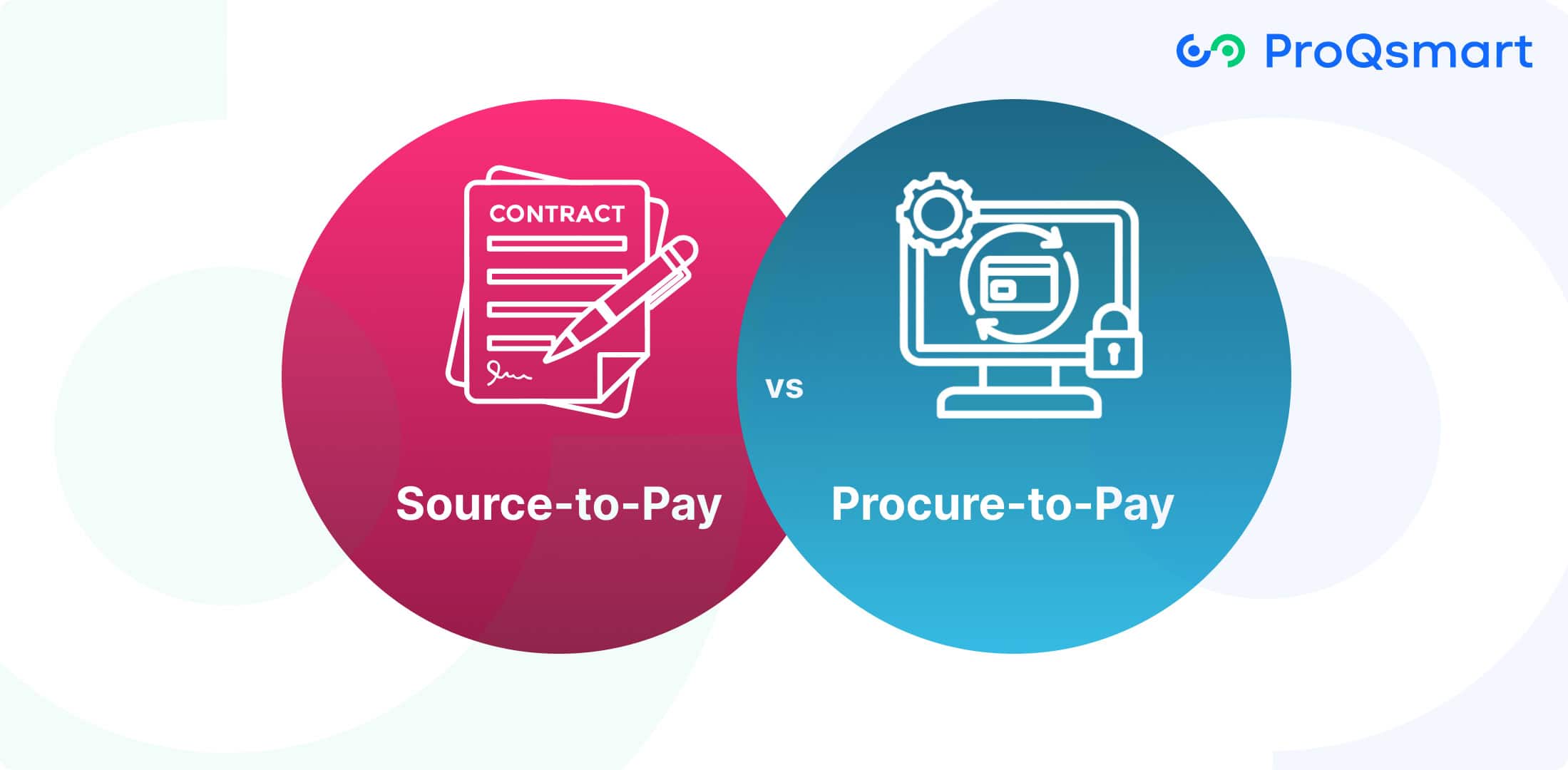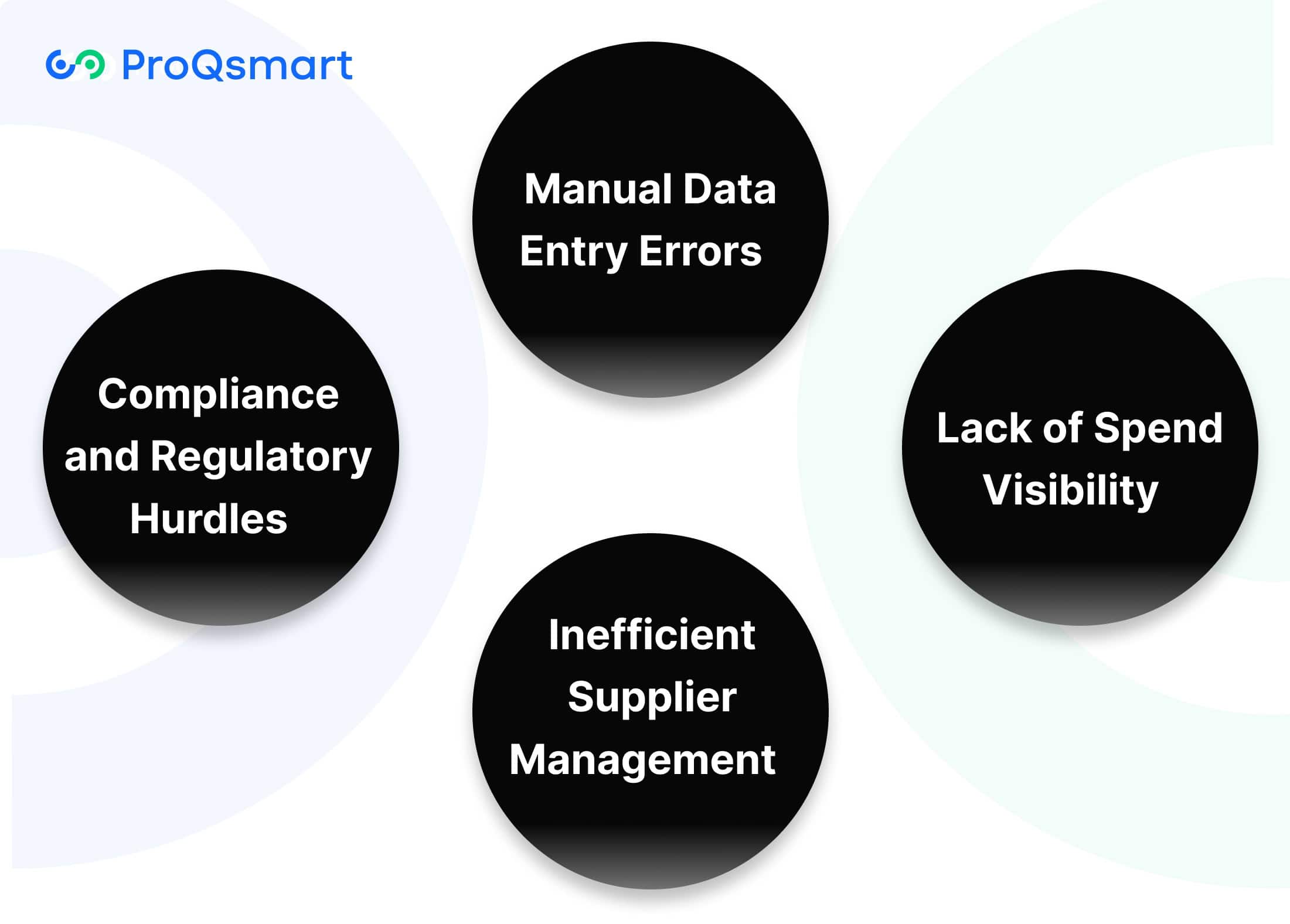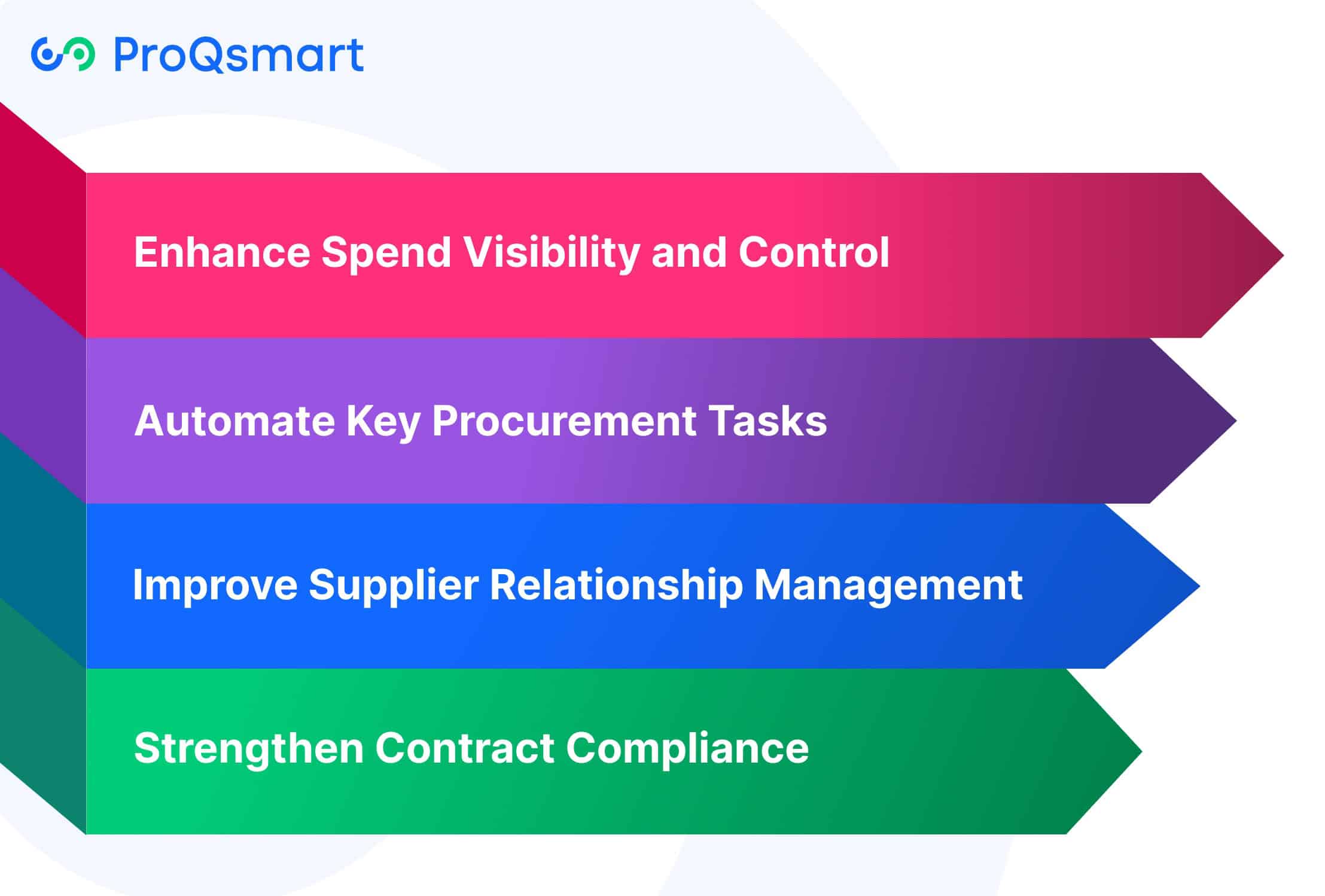Source-to-Pay (S2P) is a more holistic and extended process that combines the sourcing and procurement functions into one consolidated and structured workflow. It encompasses the entire lifecycle, from finding suppliers and sourcing goods to fulfilling orders to vendors and paying for orders.
With S2P, organizations get greater transparency, better supplier collaboration, and more cost efficiency by leveraging a single source of data and automation. This chain of process minimizes the potential for human error, improves procurement cycle time, and makes sure regulatory standards are maintained.
For enterprises facing ever-evolving global supply chains, S2P provides valuable, actionable insights and predictive reporting capabilities to enable smart, powerful, data-driven decisions. In subsequent sections, we’ll discuss how realizing the promise of S2P can change the game for procurement on the operations front.
Further, we’ll go over the recurring challenges professionals face on the ground.
What is Source-to-Pay (S2P)?
Source-to-Pay (S2P) is an integrated, end-to-end procurement process that encompasses all activities starting at the sourcing of suppliers to payment. The process goes beyond just using a single RFP to determine potential suppliers.
Next, it impacts how organizations execute procurement, process invoices, and make payments. Source-to-Pay (S2P) takes a broader, more strategic approach than Procure-to-Pay.
Source-to-Pay (S2P) goes deep into strategic processes like supplier management and contract negotiations. Besides, by taking this more holistic view, procurement can better facilitate their organization’s overall objectives, driving efficiencies, savings, and innovation from suppliers.
Stages within the S2P Cycle
|
Stage |
Purpose |
|---|---|
|
Spend Analysis |
Identifies spending patterns to uncover cost-saving opportunities. |
|
Supplier Management |
Develops and maintains strong supplier relationships for long-term value. |
|
Contract Management |
Ensures compliance and clarity in supplier agreements. |
|
Procurement Execution |
Facilitates seamless sourcing and purchasing processes. |
|
Order Management |
Tracks and manages procurement orders efficiently. |
|
Invoice Processing |
Ensures accurate and timely invoice handling. |
|
Payment |
Completes the cycle with secure and timely supplier payments. |
Each step enables the subsequent one, forming an integrated process that eliminates gaps leading to waste. Accurate Spend Analysis allows you to make better decisions when selecting your suppliers in Supplier Management.
Robust Contract Management significantly mitigates risks overall in the Procurement Execution phase. Collectively, these stages allow organizations to better control costs, mitigate compliance risk, and also improve supplier performance.
It’s true—continually adopting advanced S2P platforms is crucial for continued success. These platforms bring all of these stages together into a more connected system.
These integrated platforms help organizations streamline workflows, centralize data visibility, and improve cross-departmental decision-making. Just 59% of organizations today leverage AI-driven tools for governance of sourcing and as well as category management.
This trend is indicative of just how much they’re leaning on technology to deliver stronger procurement outcomes.
Source-to-Pay Benefits for Hospitality Industry
-
- Simplification of Procurement Operations: S2P solutions streamline procurement processes, reducing complexity and improving efficiency.
- Improved Supplier Engagement: Enhanced collaboration tools facilitate better communication and partnerships with suppliers, promoting trust and transparency.
- Increased Compliance: Automation helps ensure regulatory compliance by standardizing processes and reducing manual errors.
- Visibility and Risk Management: S2P provides complete visibility into procurement activities, helping eliminate maverick spend and mitigate supplier risks.
- Efficiency in Invoicing and Payments: Automated workflows simplify invoice processing and payments, reducing manual work and the risk of human error.
- Supplier Performance Tracking: Platforms like ProQsmart offer real-time tracking of supplier performance, enhancing accountability and contract management.
- Cost Control and Strategic Sourcing: S2P automation supports strategic sourcing strategies, leading to significant cost savings by minimizing procurement inefficiencies.
- Operational Efficiency and Consistency: Integration of S2P solutions ensures operational consistency and efficiency, crucial for maintaining high-quality guest experiences.
- Compliance and Budget Alignment: S2P helps align procurement with budgets, preventing value leakage and ensuring regulatory compliance.
- Informed Decision-Making: S2P solutions provide accurate, auditable data, enabling informed decisions that drive operational excellence and guest satisfaction.
Source-to-Pay vs. Procure-to-Pay

Understanding the difference between Source-to-Pay (S2P) and Procure-to-Pay (P2P) is crucial for sharpening procurement’s strategic edge. P2P focuses on the operational aspect of procurement, managing day-to-day activities such as purchase order management, invoice processing, and payment processing. This operational conversely focus is just one part of the larger S2P framework that encompasses a comprehensive supply chain strategy.
S2P, on the other hand, adopts a more strategic perspective. It serves as a single platform to manage the entire procurement lifecycle, from strategic sourcing and supplier evaluation to contract management and spend management. This integrated procurement process allows for a more effective alignment with business objectives, including sustainability goals.
|
Aspect |
Source-to-Pay (S2P) |
Procure-to-Pay (P2P) |
|---|---|---|
|
Scope |
End-to-end, including sourcing, contracting, and spend analysis |
Focuses on procurement execution and payment processes |
|
Strategic Focus |
Optimization of sourcing strategies, supplier collaboration |
Operational efficiency in procurement and payment |
|
Technology Integration |
AI-driven tools for strategy and decision-making |
Automation of purchase orders and payment workflows |
|
Key Activities |
Source-to-contract, eProcurement, spend management |
Invoice processing and reconciliation |
Besides, by leveraging cutting-edge procurement software solutions, S2P redefines the sourcing process. It also enhances supplier relationships and aligns procurement efforts with broader organizational objectives, such as ESG goals. For example, platforms like ProQsmart utilize AI to automate workflows, improve supplier communication, and ensure compliance, thereby fostering a streamlined process.
The broader scope of S2P enables companies to minimize risks and enhance decision-making through a data-driven approach. Real-time analysis of supplier performance and market trends equips organizations to adapt swiftly in response to their ever-changing environments, ensuring optimal supplier selection and as well as performance management.
In conclusion, the evolution of procurement technology is transforming how enterprises manage their supply chains. Besides, by adopting intelligent procurement tools, businesses can achieve greater efficiency and transparency, ultimately leading to improved cash flow and timely payments.
Source-to-Pay Challenges in Hospitality Projects

The unique challenges the hospitality industry faces with supply chain management and source-to-pay (S2P) processes mainly arise from the industry’s vibrant and service-focused aspects. These challenges have a direct impact on procurement efficiency and require custom procurement software solutions to address unique operational complexities effectively.
1. Manual Data Entry Errors
Manual data entry from bid documents can result in erroneous submissions that can break the procurement workflow. This makes it easier for errors in purchase orders or invoices to result in delayed payments, negatively impacting supplier relationships.
Additionally automation tools can help mitigate these issues. The advanced S2P systems automatically eliminate instances of human error. They improve the efficiency of data capture and validation.
Moreover, automation of checks, such as automated error detection protocols, should be implemented to maintain procurement records accuracy and consistency.
2. Lack of Spend Visibility
Lack of visibility to what’s being spent, where it’s being spent, and on what hampers strategic decision-making and overall cost management. In fact, in one case, under 10% of their spend was monitored through purchase orders—which resulted in a lot of maverick spending.
Similarly, S2P solutions that are armed with analytics offer up-to-date visibility into spending patterns. This enables organizations to identify new potential cost-saving opportunities such as supplier consolidation and also better contract negotiations.
3. Inefficient Supplier Management
Supplier onboarding and monitoring are negatively impacted by a lack of uniform standards. An optimized S2P system can centralize and significantly streamline supplier evaluations, from contract compliance to IT security policies to financial solvency.
Besides, by simplifying these processes, companies build a rapport with suppliers. This creates a productive relationship for years to come.
4. Compliance and Regulatory Hurdles
Meeting compliance requirements—including financial and InfoSec regulations—can be a time-consuming process.
Through real-time collaboration and tracking, S2P tools proactively manage these prerequisites. This correspondingly ensures adherence while mitigating risks.
How S2P Solutions Improve Hospitality Procurement

Source-to-Pay [S2P] solutions in finance significantly enhance hospitality procurement by addressing inefficiencies and streamlining processes. As many enterprises adopt integrated procurement software solutions, they not only reduce costs and as well as drive operational efficiency but also improve supplier performance management and foster effective supplier management for optimal supplier selection.
Enhance Spend Visibility and Control
S2P solutions offer real-time visibility into spending, allowing procurement teams to better track expenditures against budget. This level of transparency means budgets are respected, so projects don’t go over budget.
Advanced analytics within S2P platforms proactively identify cost-saving opportunities, like consolidating suppliers or renegotiating contracts, allowing procurement teams to act fast. Organizations leveraging these tools can more easily spot trends in what they buy over and over.
Therefore, this allows them to maximize the benefits of bulk orders, minimize costs, and improve efficiency.
Automate Key Procurement Tasks
Automating repetitive procurement tasks reduces the risk of mistakes and speeds up procurement activities. Additionally, key tasks such as purchase order generation, invoice matching and automated approval workflows are streamlined.
Besides, by automating and standardizing these processes, S2P platforms help stakeholders reduce processing times and reclaim time for more strategic initiatives. ProQsmart, for example, automates workflows, ensures procurement stays in line with budgets, and manages subcontractor pre-qualifications to eliminate workflow gaps.
Improve Supplier Relationship Management
Strong supplier relationships are critical in hospitality procurement. S2P platforms enable regular performance evaluations and communication, ensuring suppliers meet expectations.
ProQsmart’s tools for tracking supplier performance and fostering real-time collaboration enhance trust and reliability, supporting long-term partnerships.
Strengthen Contract Compliance
Given the number of contacts involved and the complexity of contract terms, monitoring compliance is critical. S2P solutions automatically track agreements, providing checks and balances to ensure all parties fulfill their obligations.
ProQsmart’s auditable sourcing data helps hospitality organizations stay compliant with regulations, increasing transparency in their procurement processes.
Technology’s Role in Source-to-Pay
Transforming S2P with Automation
Technology has fundamentally reshaped the source-to-pay (S2P) process, equipping organizations with tools that eliminate inefficiencies and support strategic decision-making. Advanced software solutions have fully automated traditionally manual tasks, such as purchase order approvals and supplier evaluations, which previously suffered from disconnected workflows and departmental bottlenecks.
Besides, by leveraging these technologies, businesses achieve greater agility and accuracy, reducing errors and fostering productive collaboration between departments.
The Power of AI in Source-to-Pay
One of the most transformative advancements in S2P is artificial intelligence (AI), which enhances platforms with capabilities such as:
- Fraud detection to flag suspicious transactions.
- Supplier risk monitoring for proactive issue resolution.
- Category management accelerators that refine procurement strategies.
For example, embedded AI tools can automatically detect anomalies in supplier invoices, allowing procurement teams to mitigate risks before they escalate. Additionally, mobile-friendly and intuitive interfaces simplify procurement operations, ensuring all stakeholders can engage efficiently.
Enhancing Visibility and Collaboration
An integrated S2P platform enhances supply chain management by providing real-time visibility across the procurement lifecycle, fostering stronger cooperation between internal departments and external vendors. By automating workflows and tracking supplier performance, companies can ensure seamless collaboration and increased transparency throughout the procurement process.
The Cost of Delaying Implementation
To maximize the benefits of S2P technology, many enterprises must engage S2P and ERP technology teams early in the design phase. Failing to do so can lead to an inefficient procurement process, delayed updates, reduced efficiency, and lost ROI opportunities—potentially costing organizations up to 15% of their ROI potential for every day of delay.
Enhancing Supplier Management Practices
For organizations, smart supplier management through the Source-to-Pay (S2P) process enhances operational efficiency and cash flow, reduces costs, and ensures compliance with industry regulations. By leveraging procurement software solutions and fostering collaboration, companies can build resilient supply chains that align with their business goals.
Supplier Selection and Onboarding
Finding and choosing suppliers today takes more than a gut feeling. Key criteria include financial stability and compliance with industry standards, quality of goods and services, sustainability and ethical practices, and technological capability to integrate with procurement systems.
Thorough due diligence, such as reviewing certifications and compliance records using NLP capabilities, ensures alignment with regulatory requirements and organizational values. A well-defined onboarding process, including automated workflows like those provided by ProQsmart, streamlines transitions, minimizes delays, and fosters strong initial relationships.
Performance Monitoring and Evaluation
Against that criteria, ongoing supplier performance must be monitored using standard, accepted metrics such as delivery requirements, quality metrics, and affordability/cost-structure. These regular evaluations, enhanced by AI-powered SRPM tools, offer a comprehensive view of supplier governance and risk to guide better sourcing decisions.
Clear communication of performance expectations holds suppliers accountable and helps guarantee delivery of the main objectives expected from the start.
Risk Management and Mitigation
Non-compliance, over-dependency on single suppliers, supply chain disruptions – and even social issues – are just the tip of the iceberg. Proactive strategies, like diversifying supplier bases and implementing AI to identify discrepancies in invoices or industry certifications, help prevent risk.
ProQsmart’s risk management tools improve visibility — so you can maintain secure, sustainable procurement operations.
Collaboration and Communication
Collaboration is the key ingredient to S2P success. Increasing collaboration and automating business processes are essential. Real-time integrated collaborative platforms such as ProQsmart enhance communication, collaboration, supplier relationships, and further automate document management.
Additionally, AI-powered tools allow real-time interactions that increase performance and build trust among all stakeholders involved.
Conclusion
Source-to-Pay (S2P) is more than just a process—it is a strategic framework that enhances cost efficiency, supplier relationships, and operational transparency. In the hospitality sector, S2P solutions minimize waste, streamline workflows, and ensure audit-ready compliance, making procurement more structured and scalable.
With ProQsmart’s advanced S2P solutions, organizations can enhance cost predictability, improve sourcing efficiency, and strengthen compliance measures. A well-executed S2P strategy not only reduces inefficiencies but also positions your business for long-term success.
Take the next step in optimizing your procurement operations. Book a demo with ProQsmart today and explore how our solutions can drive measurable improvements in efficiency, cost management, and supplier collaboration.




